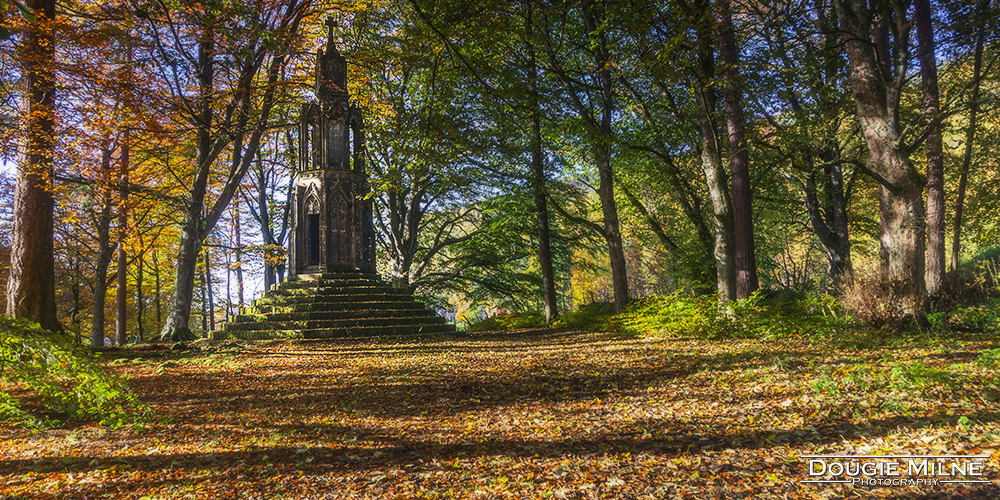
Click on picture for buying options
Tweet
As children, back in the early 1980s, my parents used to take us camping at Kenmore in Perthshire. The village sits at the eastern end of Loch Tay, next to an 18th century bridge which crosses the River Tay as it leaves the loch. We spent our days playing in the loch and the river, and climbing the surrounding hills.
One of our favourite family walks took us from the bridge, along the northern bank of the river and into the woodland that surrounds the village - part of the lands of Taymouth Castle, the former home of the Earls of Breadalbane. There, sitting on its own in a clearing in the middle of the forest, was a mysterious thirty-foot tall gothic tower. We had recently been introduced to the works of Tolkein, and here was one of the Two Towers. At any minute, we knew we could be overrun by orcs and goblins...
Thirty-five years later, my wife and I took the same walk along the Tay, and there in a woodland clearing was the same eerie monolith. A set of concentric stone octagons form steps around the foot of the tower which lead to a heavy slate door and a spiral staircase up the inside. The staircase opens out to a viewing gallery halfway up. The tower is topped with a square pinnacle surmounted by a cross.
Closer inspection revealed an inscription on a brass tablet:
This Building is Dedicated to my Faithful Friend and Fellow-Labourer,MARY, COUNTESS OF BREADALBANE,Whose maternal care has been long extended to all around this place.anno domini, 1831.
Who was Mary, and who was the friend who had erected this tower to her memory nearly two-hundred years ago?
According to the OS Map, the tower is known as Maxwell's Temple.
"Maxwell" is probably William Maxwell of Preston, Kirkcudbrightshire. Maxwell had made his money in the sugar trade in the West Indies. His daughter, Willielma, married John Campbell, youngest son of the Third Earl of Breadalbane a year after her father's death in 1760.
A 1786 plan of the grounds of Taymouth Castle, drawn up by George Langlands, shows a gazebo or summerhouse named Maxwell's Building on the site of the present tower. It is tempting to imagine young John erecting a gazebo in the grounds of his father's castle in memory of his new wife's late father.
John Campbell died in 1771. He was survived by his father. There were no direct hiers, so the Earldom was passed to a distant cousin, also John Campbell, who became the Fourth Earl of Breadalbane in January 1782 at the age of 19.
As a Scottish peer, he was not automatically entitled to sit in the House of Lords, but he was elected as one of the sixteen Scottish Representative Peers in 1784.
In the summer of 1793, after Britain became involved in the French Revolutionary Wars, he raised the Breadalbane Fencibles Regiment, serving initially as a lieutenant-colonel.
In September that same year, Campbell married Mary Turner Gavin. Mary, who was born around 1770, was the daughter of David Gavin, of Langton House, Berwickshire, and granddaughter of the 7th Earl of Lauderdale. As he was an earl, she automatically became the Countess of Breadalbane - the title she is given on the brass tablet on the tower.
When the Breadalbane Fencibles were disbanded in 1802, Campbell remained in the army and was promoted to colonel. In November 1806, he became Baron Breadalbane, of Taymouth Castle in the County of Perth after he was made Councillor of State to the Prince of Wales.
The tower was designed by the architect William Atkinson, on the instruction of Baron Breadalbane. It was built in 1830, replacing Maxwell's Building.
It was modelled on the Eleanor Crosses, a series of twelve ornate stone monuments, each topped with a cross, which form a line down part of the east of England. The Crosses were built on the orders of King Edward I between 1291 and 1295 in memory of his late wife Eleanor of Castile. Each cross marked the resting place of her body as it was returned to London following her death in Harby, Nottinghamshire in November 1290. Most of the Eleanor Crosses no longer exist, including the largest, which gave its name to Charing Cross in London. There are three survivors, at Geddington, Hardingstone and Waltham Cross.
Like Edward I before him, Campbell wanted a memorial to his wife. Unlike Eleanor, Mary was still alive when it was dedicated to her in 1831.
The year after he built the tower, in September 1831, Campbell was made Marquess of Breadalbane, following the coronation of William IV. Mary automatically became the Marchioness of Breadalbane.
Campbell died at Taymouth Castle in March 1834, at the age of 72 following a short illness. Mary died in September 1845, aged around 75 years old.
Nearly two centuries after it was built, her cross stands as a testament to the love of her husband.
This picture was taken on 1 November 2015.